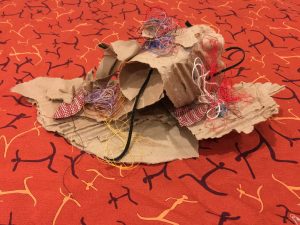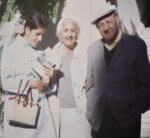A collaboration of various authors on the subject of the Idealized Self Image, the damage it does and the promise of recovery – into our sacred humanness. Our true nature. Thank you to all you brave souls who contributed.

Image Above – The Idealized Self Image as Constructed by Susan G. — variegated cardboard is material she visualized, flimsy and inadequate for supporting all the structures she puts on top. She adorns it with various ornamentation – random, without coherence. This is a beautiful portrayal of the idealized self. Individually each piece representing a belief about life and ourselves, makes sense but the overall construction … well draw your own conclusions!
A Pathwork Lecture says, “As a child, regardless of what your particular circumstances were, you were indoctrinated with admonitions on the importance of being good, holy, perfect. When you were not, you were often punished in one way or another. Perhaps the worst punishment was that your parents withdrew their affection from you; they were angry, and you had the impression you were no longer loved. No wonder “badness” associated itself with punishment and unhappiness, “goodness” with reward and happiness. Hence to be “good” and “perfect” became an absolute must; it became a question of life or death for you. Still you knew perfectly well that you were not as good and as perfect as the world seemed to expect you to be. This truth had to be hidden; it became a guilty secret, and you started to build a false self.” PWL #83
I am working with several people who are doing the sacred work of deconstructing the mask of the Idealized Self that they have constructed over so many years. The Idealized Self Image is what the Pathwork calls the perfectionist standards that we hold ourselves to and present to the world. The ISI is made of many images (beliefs about the world and ourselves that we formed during our sorting and categorizing stage of our brain development. My four year old grandchild is doing this now. “I have a penis, Daddy has a penis – you and Mommy do not have penises”. The conclusions he will draw about men and women will form a lasting image that will become unconscious because of his young age. Many images also contain conclusions about cause and effect. The young one trying to make order and sense out of the world. If I do this _______ then that ________ will always happen. We have a myth in our family – if you wear your pajamas inside out it will snow when you wake up the next morning. Some of our unconscious images can be just as magical or erroneous as this one and make little sense in the light of day of our grown up psyches.
Here is one example. It begins with her belief that, “I am special and therefore inoculated against anything bad happening to me.” (We can smile at the magical thinking of her little one). “Next, something bad does happen. Then I decides I better hide and make myself small.” (This plays out in adulthood with eating disorders and other issues). ” But then I am hungry, and so lonely and so afraid. If I keep making myself a better (special) person maybe that will help. But then I fail at my expectations and bad things keep happening and I hide and get small again. The world feels like a very unsafe place.” This is something that all Idealized Self Images have in common. The world does not feel safe.
Someone else has a different cascade of images that leads him to loneliness and often severe depression. Here is how his goes:
“I cannot feel support, If I were to feel support then it would not be enough. If the support is not enough then I am alone. If I am all alone then I am not enough. If I am not enough then life is hopeless (here is where the depression begins). “If life is hopeless than I have to try harder. If I try harder then it is never enough. I give up any hope of relationship. Then I am really alone.” This one is a bit trickier. His Idealized Self Image rests in not needing support, in being able to do it all by himself. and with an arrogance that he will do it better than anyone anyway. But it does leave him frightened and alone. Because deep down inside we do not believe the story of our ISI’s. We present it to the world but we know it are false.
In these two cases you can see two tendencies of the ISI combined: over-exacting moral standards – impossible to live up – and pride in being invulnerable, aloof, and superior. The co-existence of these mutually exclusive strategies presents a particular hardship for the psyche.
Another person is very accomplished in her field. Yet she cannot relax into all her accomplishments because, though they are true and well earned, she also has these over-exacting standards that she knows in her heart of hearts she cannot live up to. This makes her constantly vigilant that she will be discovered as a fraud – exposed.
“A further and drastic result of this problem is the constantly increasing estrangement from the real self. The idealized self is a falsity. It is a rigid, artificially constructed imitation of a live human being.” PWL 83
It can be hard work to excavate the real self amidst this life long construction project of the false self. Another person writes, “Yes, it (the ISI) needs to somehow, at some point, be replaced. Talk about being disoriented!! Sometimes love just seems so much like the lack of it. So imperfect. And yet in its imperfection, stronger, more pure, more meaningful. Sacredly human. It feels so scary to trust this imperfection.”
Another person writes:
“My mask of love was so thick and layered with the mask of power and then surrender if all else failed. I was aware of this for decades before I could find a way out. These days I am risking it all to live authentically – with my flaws and the truth that I will always be in recovery and wishing to find underneath it all what of the joy, love, giving and effort I launched into life which is actually real. Today I pray – to be real, to feel and sense and speak truth – and to stay close to me. A me I never sensed, while in the frenzy to flee and function.”
There is so much creativity. hard work and hope in these examples of deep excavation, art work and writing. I hope you will feel the hope too and join us in embarking on trusting your imperfect, human self. Staying close to yourself – who you really are – makes the world a much safer place.
“
